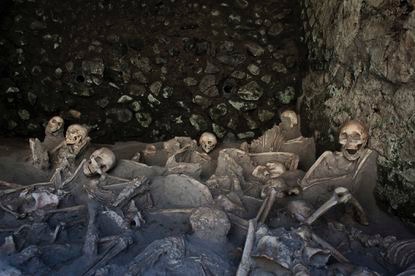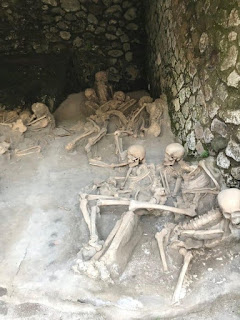 | The beach at the Herculaneum archaeological park, located in Campania, opened in June 2024 after a multi-year restoration project. Herculaneum lay buried under 35 meters of solidified ash until it was discovered by chance in 1709 as a worker drilled a well for a monastery. |
 | Digs in the 1980s and '90s uncovered the skeletons of more than 300 people in stone boathouses near the beach. They died from the heat as they awaited rescue by Pliny the Elder..webp) |
 | Work at the Antica Spiaggia area began in January 2022. It was already partially excavated in the 1980s. Dozens of skeletons were found, including the famed 'Ring Lady,' named for the rings on her fingers. Herculaneum was much closer to Vesuvius than Pompeii, and was buried by pyroclastic surges. Excavations unearthed lavish villas, organic matter such as fruit and bread, wooden furniture, and hundreds of charred papyrus scrolls. |
 | Evidence was found of high temperatures on the skeletons of those found in the arched vaults on the seashore, which is now 500 metres inland, as well as the existence of carbonized wood in the boathouses, which became their tombs. The beach is now about four metres below current sea levels. |  |
 | In 2021, the skeleton of a man dubbed the “last fugitive,” was found. Its believed he had been attempting to escape toward the sea with his valuables. The man was aged between 40 and 45 and was found with a heavily blackened skull and bones with numerous heat-induced fractures. Under the left arm of the skeleton was a cloth shoulder bag inside which was a wooden box containing objects in metal, pieces of cloth, and traces of gold. He suffered the same fate as the others. The extremely high temperatures of the pyroclastic flow caused human tissue to instantly vaporize and the skeleton was imprisoned in a mass of ash, gas and debris. |  |
 | Dubbed the ‘Herculaneum 300’, their remains were found just four miles (6.43 km) from Mount Vesuvius. Historians have suggested the group was minutes away from being rescued by Pliny the Elder, commander of the local naval fleet. His nephew, Pliny the Younger, wrote two letters describing the eruption, both of which have great historical significance due to their accurate description of the eruption. |

No comments:
Post a Comment